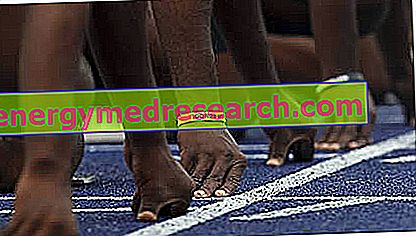Generality
The radial capital is the characteristic enlarged area that constitutes the proximal end of the radium.

Completely smooth due to the presence of a layer of articular cartilage, the radial capital is the portion of the radio delegated to interact with the humerus, to form the articulation of the elbow, and with the proximal end of the ulna, by gender the proximal radio-ulnar joint.
Because of the position it occupies, the radial capital is the part of the radio most at risk of fracture, on the occasion of a fall on an extended arm.
Responsible for pain and swelling of the elbow, fractures of the radial capital may be more or less serious; the severity of a fracture of the radial capital is important, because the therapeutic approach adopted depends on it.
What is the Radial Capital?
The radial capital, or radial head, is the proximal apex of the radium as well as the portion of this bone of the forearm destined to constitute, with the ulna and the humerus, the articulation of the elbow .
The radial capital owes its particular name to the resemblance to the top of the columns of the Greek temples (in particular those of the Doric order), the summit which is precisely called "capital".
Anatomical meaning of "proximal" and "distal"
" Proximal " means "closer to the center of the body" or "closer to the point of origin"; " distal ", instead, means "farther from the center of the body" or "farther from the point of origin.
Examples:
- The femur is proximal to the tibia, which is distal to the femur.
- In the femur, the extremity bordering the trunk is the proximal end, while the extremity bordering the knee is the distal end.
Short review of the Anatomy of the Radio
To fully understand the position of the radial capital and understand its functions, it is necessary to review some fundamental anatomical concepts relating to the bone of the human body called the radio:
- Radium is the equal bone of the human body which, together with the ulna, constitutes the skeleton of the forearm;
- Located in a lateral position with respect to the ulna (in the hypothesis in which the forearm is extended along the side and the palm of the hand facing the observer), the radius is a classic long bone, therefore it has a central cylindrical portion, called body, and two bulky ends, called proximal epiphysis and distal epiphysis ;

- In the radius, the proximal epiphysis represents the bone portion closest to the humerus ( arm bone) and which, with the latter and the ulna, forms the elbow joint;
- In the radius, the body constitutes the cylindrical bony portion that elapses between the proximal epiphysis and the distal epiphysis;
- In the radius, the distal epiphysis represents the bone portion closest to the bones of the carpus of the hand and, with the latter, generates the articulation of the wrist.
Anatomy
The radial capital is the top of the proximal radium epiphysis .
Preceded by a narrower portion called the neck of the radium, the radial capital has the appearance of a pawn of the lady, whose upper surface and whose edge are completely smooth due to the presence of a layer of articular cartilage .
Upper surface of the Radial Capital

The upper surface of the radial capital is the upper face of the radius as well as the area of this bone closest to the humerus, ie the arm bone.
Smooth thanks to the so-called articular cartilage, the upper surface of the radial capital is the portion of radium involved in the elbow joint; in fact, it interacts with the semi-spherical portion of the humerus known as capitulum .
In the ulna, the equivalent of the radial capital is the bone structure of the proximal epiphysis consisting of olecranon and trochlear recess .
For the purpose of the elbow joint, the olecranon-troclear recess of the ulna is articulated with a portion of the humerus called troclea, located next to the capitulum .
Edge of the Radial Capital
By edge of the radial capital is meant, in fact, its perimeter.
The medial section is particularly relevant to the edge of the radial capital, since it is the bone portion destined to join the proximal epiphysis of the radium to the proximal epiphysis of the ulna, in a place of this that is called a radial recess.
The connection between the proximal epiphysis of the radium and the proximal epiphysis of the ulna constitutes an articulation, which the anatomists indicate by the name of " proximal radio-ulnar joint ".
The proximal radio-ulnar joint is one of the 3 joints that hold radius and ulna together (the other two are the interosseous membrane with the radial body and the ulnar body, and the distal radio-ulnar joint between the ulnar hollow of the radio and the head of the ulna).
What does the Radial Capital support?
Below the radial capital, to act as supporting elements, there are, in order, the so-called radial neck and radial tuberosity .
On the neck of the radio there is little to say, except that it is narrower than the radial capital; the radial tuberosity, on the other hand, is very interesting from the anatomical point of view, as it is the portion of the radio designed to accommodate the terminal head of the biceps brachialis muscle.
Function
The radial capital covers two important functions, of which this article has already spoken; these functions are:
- Join the proximal end of the radius to the distal end of the humerus, for the purpose of the elbow joint;
- Join the proximal end of the radius to the proximal end of the ulna, to keep the bones of the forearm together.
Elbow: what's the use?

The elbow is the synovial joint of the human body located between the arm and forearm, which allows the movements of flexion and extension of the upper limb .
Thanks to the elbow and with the help of the shoulder and the wrist, the human being is able to perform activities such as, for example, lifting weights, holding objects and moving them in space, throwing objects and writing.
diseases
Because of the position it occupies, the radial capital is a part of the radio easily victim of traumas that can cause its fracture.
According to statistics, the fracture of the radial capital would represent 20% of all injuries to the elbow, it would more often affect women than men and, finally, it would be more frequent among people aged between 30 and 40 years .
Causes of Radial Capital Fracture
In most cases, the fracture of the radial capital is the consequence of a violent fall on an extended upper limb; in these circumstances, in fact, the radial capital impacts violently against the capitulum of the humerus, shattering.
Types of Radial Capital Fractures
There are 3 types of radial capital fracture:
- The type I fracture, which is the least severe.
Description: in fractures of the type I radial capital there is only one small crack, which does not create any significant separation between the bony sections involved.
The fractures of the radial type I capital may not be visible to X-rays.
- The type II fracture, which is an intermediate gravity fracture.
Description: in fractures of the type II radial capital there is a slight breakdown of the affected bone portions.
- The type III fracture, which is the most serious.
Description: in the fractures of the type III radial capital there is a deep fragmentation of the affected bone area and, very often, also to the involvement of the elbow joint ligaments.
Symptoms of Radial Capital Fracture

The typical symptoms of a fracture of the radial capital are:
- Elbow pain ;
- Swelling at the elbow;
- Difficulty bending and straightening the elbow, accompanied by an increase in pain.
Radial Capital Fracture Diagnosis
The X-ray examination of the elbow is essential for the diagnosis of a radial capital fracture.
Radial Capital Fracture Therapy
The treatment of a fracture of the radial capital varies according to the severity of the injury.
Specifically, for less severe fractures, a conservative treatment is sufficient, focusing on a period of immobilization, by means of plaster or a rigid guardian, of the affected upper limb; for serious fractures, on the other hand, a surgical treatment plan must be implemented to weld the bone fragments, followed by a period of immobilization and physiotherapy sessions (used to restore elbow mobility).
DURATION OF IMMOBILIZATION
In general, fractures of the radial capital require a period of immobilization lasting 2-3 weeks .
Immobilization is essential to facilitate the welding of cracks or fragmentation.
SURGERY: SOME MORE DETAILS
Surgical operations for the management of more severe radial capital fractures may include:
- The insertion of screws or pins to promote welding;
- The replacement with metal parts of bony portions shattered and not recoverable;
- The repair of the ligaments of the elbow victims of injury.
Recovery Times from a Radial Capital Fracture
To recover satisfactorily from a radial capital fracture, they serve on average 6 to 8 weeks .
In the case of serious fractures of the radial capital, the healing time could be longer and, in the case of involvement of the elbow joint, the latter could never fully recover its natural mobility.
In order to hope for a better recovery from a fracture of the radial capital, it is essential to respect the doctor's indications regarding therapy.



